Ecotones are transition zones where two distinct ecosystems meet and integrate, creating unique habitats with high biodiversity and ecological complexity. These areas often serve as critical buffers that support species diversity, enhance ecosystem resilience, and enable natural adaptation to environmental changes. Discover how understanding ecotones can enrich your appreciation of natural landscapes and improve conservation efforts throughout this article.
Table of Comparison
| Feature | Ecotone | Ecocline |
|---|---|---|
| Definition | Transition zone between two distinct ecosystems or communities. | Gradient zone showing gradual environmental changes across a landscape. |
| Boundary Type | Sharp or distinct boundary. | Continuous and gradual boundary. |
| Species Diversity | High biodiversity, includes species from adjacent ecosystems and unique species. | Gradual species turnover along the environmental gradient. |
| Environmental Variation | Distinct environmental conditions contrasting the two ecosystems. | Progressive variation in factors like moisture, temperature, or soil type. |
| Ecological Importance | Supports unique habitats, enhances biodiversity, acts as buffer zone. | Indicates gradual adaptation of species to changing environments. |
| Examples | Forest-meadow edge, wetland-upland interface. | Elevation gradient in mountain slopes, salinity gradient in estuaries. |
Introduction to Ecotone and Ecocline
Ecotones are transitional zones where two distinct biological communities meet and integrate, often showing a sharp change in species composition and environmental conditions. Ecoclines represent gradual, continuous gradients of environmental factors, leading to systematic changes in species distribution across space. Understanding the differences between ecotones and ecoclines is crucial for studying biodiversity patterns and ecosystem dynamics in various habitats.
Defining Ecotone
An ecotone is a transition area between two distinct ecological communities or ecosystems where species from both environments coexist and interact, creating high biodiversity and unique environmental gradients. Unlike an ecocline, which refers to a gradual change in species composition or environmental conditions over a geographical area, an ecotone represents a more sharply defined boundary exhibiting distinct physical and biological characteristics. Ecotones often act as ecological hotspots, influencing species distribution, competition, and adaptive evolution within the interface zone.
Understanding Ecocline
An ecocline represents a gradual, continuous gradient of environmental conditions where species composition changes progressively across a spatial scale, contrasting with an ecotone that is a distinct boundary between two ecological communities. This gradient often involves variations in factors such as soil moisture, temperature, or altitude, influencing species distribution and abundance. Understanding ecoclines helps ecologists predict shifts in biodiversity and ecosystem function in response to environmental changes.
Key Differences Between Ecotone and Ecocline
Ecotones are distinct transitional zones where two different ecosystems meet and integrate, characterized by increased biodiversity and sharp environmental gradients. Ecoclines represent gradual, continuous environmental gradients where species composition changes slowly without clear boundaries. The key difference lies in ecotones having distinct boundary features and abrupt shifts in community structure, while ecoclines display smooth, progressive changes in ecological variables.
Ecological Significance of Ecotones
Ecotones represent transitional zones between distinct ecological communities, exhibiting high species diversity and unique interactions that enhance ecosystem stability and resilience. These areas serve as critical habitats for specialized species and act as buffers against environmental changes, promoting biodiversity conservation. The ecological significance of ecotones lies in their role as hotspots for genetic exchange and natural corridors facilitating species migration and adaptation.
Importance of Ecoclines in Ecosystem Gradients
Ecoclines represent gradual, continuous environmental gradients where species composition shifts progressively, facilitating adaptive responses and biodiversity within ecosystems. Their importance lies in supporting species that thrive along varying environmental conditions, promoting genetic diversity and resilience against climate change. Understanding ecoclines is crucial for effective ecosystem management and conservation across spatially dynamic habitats.
Examples of Ecotones in Nature
Ecotones represent transitional zones where two distinct ecosystems meet and integrate, such as the marshland merging into a forest or the edge of a coral reef adjoining open ocean waters. These areas often support high biodiversity due to species from both adjacent ecosystems coexisting and unique species adapted to transitional conditions. Examples of ecotones include the savanna-forest boundary in Africa, the tundra-taiga interface in the Arctic, and coastal mangrove-reef junctions in tropical regions.
Real-World Cases of Ecoclines
Ecoclines represent gradual transitions in environmental conditions resulting in continuous changes in species composition, as observed in the intertidal zones of the Pacific Northwest where salinity gradients influence the distribution of marine species. Unlike ecotones, which are distinct boundary zones, ecoclines illustrate real-world cases such as altitudinal vegetation changes on mountains in the Andes, where temperature and moisture gradients create continuous shifts in plant communities. These gradual transitions highlight the importance of microhabitats in biodiversity and ecosystem resilience across spatial scales.
Role in Biodiversity and Species Distribution
Ecotones mark distinct boundaries between ecosystems, promoting high biodiversity by hosting species from adjacent habitats and unique edge species, thus enhancing species distribution diversity. Ecoclines represent gradual environmental gradients where species distribution changes progressively, supporting biodiversity through continuous variation and adaptation across the gradient. Both ecotones and ecoclines are critical in shaping species composition and ecological interactions, influencing ecosystem resilience and evolutionary processes.
Conclusion: Implications for Ecology and Conservation
Ecotones represent distinct transitional zones with sharp environmental gradients leading to high species diversity, while ecoclines involve gradual changes in environmental factors and species composition. Understanding the differences between ecotones and ecoclines is crucial for ecological research in predicting species distribution and ecosystem responses to environmental change. Conservation strategies must prioritize ecotones for their role as biodiversity hotspots and ecoclines for maintaining genetic flow and resilience across continuous habitats.
ecotone Infographic

 libterm.com
libterm.com